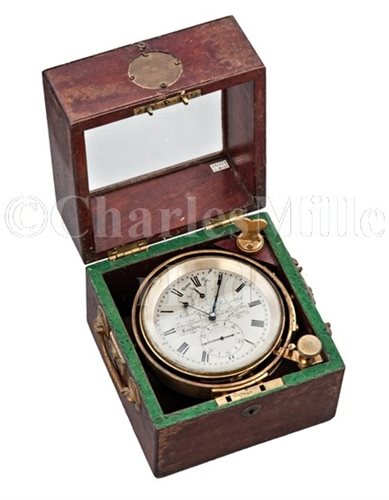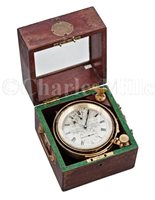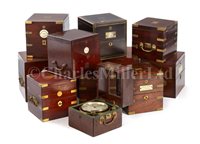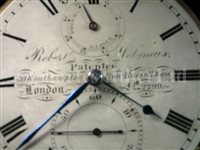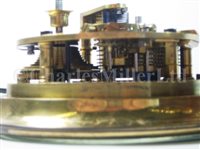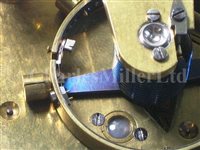29th Oct, 2014 12:00
Maritime and Scientific Models, Instruments & Art (Wizard)
163
[M] ROBERT MOLYNEUX 2-DAY MARINE CHRONOMETER WITH...
the 3½in. silvered dial signed Robert Molyneux, Patentee, 30 Southampton Row, Russell Squr, London, No. 2299, champlevé Roman numerals, subsidiary seconds and up-and-down dials, blued-steel hands, fusee and chain, Harrison's maintaining power, Earnshaw-type footed spring detent escapement, bimetallic compensation balance with peripheral temperature and meantime adjustment screws, Molyneux's auxiliary compensation, diamond endstone, free-sprung blued-steel helical balance spring, gimbal-mounted brass bowl in two-tier box (formerly three-tier, top lacking) -- 6½in. (16.5cm.) square approx.
Robert Molyneux worked from premises at 30 Southampton Row between 1832 and 1842. He patented his invention of a compensation balance with auxiliary (Patent No. 8.418) in March 1840 and initially fitted it to two chronometers which were sent for trial at Greenwich between January and June 1840. The purpose of this auxiliary, as with most auxiliary compensations, was to reduce the total effect of the middle temperature error. The principle of Molyneux's auxiliary is identical to that invented by another London maker, John Sweetman Eiffe, at around the same time but differs in construction. Very few chronometers with Molyneux's auxiliary compensation are known to exist and the present chronometer is a very rare example. Molyneux obtained some quite remarkable trial results with this auxiliary, far better than those submitted by Eiffe, but this is thought to be due in part to his painstaking workmanship. The very careful manufacture and laborious adjustment required in the manufacture of both Molyneux's and Eiffe's designs were perhaps the reason why so few were constructed. They did however form the basis for the improvements of other makers including Kullberg and Mercer.
Sold for £2,728
Estimated at £1,000 - £1,500
(inc. buyer's premium of 24%)
Condition Report
In going order, movement generally clean and with no apparent major faults,
box somewhat distressed and with top hinged lid missing and blank replaced signature plaque.
We are pleased to provide you with a general report of the condition of this property. Since we are not professional conservators or restorers, we urge you to consult with a restorer or conservator of your choice who will be better able to provide a detailed, professional report. Prospective buyers should inspect each lot to satisfy themselves as to condition and must understand that any statement made by Charles Miller Ltd is merely a subjective, qualified opinion. Prospective buyers should also refer to any Important Notices regarding this sale, which are printed in the Sale Catalogue. NOTWITHSTANDING THIS REPORT OR ANY DISCUSSIONS CONCERNING A LOT, ALL LOTS ARE OFFERED AND SOLD “AS IS” IN ACCORDANCE WITH THE CONDITIONS OF BUSINESS PRINTED IN THE SALE CATALOGUE.
the 3½in. silvered dial signed Robert Molyneux, Patentee, 30 Southampton Row, Russell Squr, London, No. 2299, champlevé Roman numerals, subsidiary seconds and up-and-down dials, blued-steel hands, fusee and chain, Harrison's maintaining power, Earnshaw-type footed spring detent escapement, bimetallic compensation balance with peripheral temperature and meantime adjustment screws, Molyneux's auxiliary compensation, diamond endstone, free-sprung blued-steel helical balance spring, gimbal-mounted brass bowl in two-tier box (formerly three-tier, top lacking) -- 6½in. (16.5cm.) square approx.
Robert Molyneux worked from premises at 30 Southampton Row between 1832 and 1842. He patented his invention of a compensation balance with auxiliary (Patent No. 8.418) in March 1840 and initially fitted it to two chronometers which were sent for trial at Greenwich between January and June 1840. The purpose of this auxiliary, as with most auxiliary compensations, was to reduce the total effect of the middle temperature error. The principle of Molyneux's auxiliary is identical to that invented by another London maker, John Sweetman Eiffe, at around the same time but differs in construction. Very few chronometers with Molyneux's auxiliary compensation are known to exist and the present chronometer is a very rare example. Molyneux obtained some quite remarkable trial results with this auxiliary, far better than those submitted by Eiffe, but this is thought to be due in part to his painstaking workmanship. The very careful manufacture and laborious adjustment required in the manufacture of both Molyneux's and Eiffe's designs were perhaps the reason why so few were constructed. They did however form the basis for the improvements of other makers including Kullberg and Mercer.
Auction: Maritime and Scientific Models, Instruments & Art (Wizard), 29th Oct, 2014
